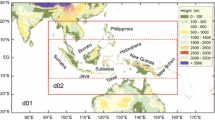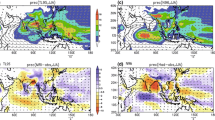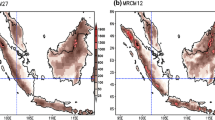Abstract
The General Circulation Models experience a significant challenge in realistically simulating rainfall over the tropical Maritime Continent (hereafter, MC). Here, we investigate the mechanisms of an improvement in monthly rainfall simulation over the MC region in the UK Met Office Unified Model (version Global Atmosphere 6.0), which occurs when the horizontal resolution is increased from N96 (grid spacing ~135 km) to N216 (~60 km). The increased resolution enhances the area-averaged rainfall rate over the MC, thereby reducing the dry rainfall bias seen in the model at the N96 resolution. We find that the enhanced area-averaged rainfall is mostly due to an increase in the medium rainfall rates that occurs over the MC islands in the N216 experiment. The rainfall change is predominantly associated with changes in the atmospheric convective circulation and the related horizontal moisture flux convergence. The vertical profiles of convective circulation show a strong sensitivity to the increased horizontal resolution over the MC islands, but not over the surrounding oceans. It is shown that a significant underestimation of the deep convection (as opposed to the shallow convection) in the N96 experiment is primarily responsible for the stronger dry bias in this experiment. We present evidence that the dry bias, and the associated weaker deep convection, are in part caused by the strongly smoothed orography used in the N96 experiment, which provides a weaker orographic lifting of the moist surface air (in a conditionally unstable atmosphere) than that in the N216 experiment.










Similar content being viewed by others
Notes
Similar differences between the N96 and N216 rainfall distributions are also found when the distributions are computed from the higher temporal resolution (daily) data.
The effects of the sub-grid scale orography is parameterized in the MetUM in terms of flow blocking and gravity wave drags, as detailed in Walters et al. (2014).
Over the coastal grid boxes, the surface roughness is larger than over the surrounding seas due to the presence of land. This reduces the model’s lowest level wind speed in the coastal points, leading to reduced latent heat fluxes there (Schiemann et al. 2014).
References
Adler RF, Huffman GJ, Chang A et al (2003) The version-2 global precipitation climatology project (GPCP) monthly precipitation analysis (1979–present). J Hydrometeorol 4:1147–1167. doi:10.1175/1525-7541(2003)004<1147:TVGPCP>2.0.CO;2
Bacmeister JT, Wehner MF, Neale RB et al (2014) Exploratory high-resolution climate simulations using the community atmosphere model (CAM). J Clim 27:3073–3099. doi:10.1175/JCLI-D-13-00387.1
Birch CE, Roberts MJ, Garcia-Carreras L et al (2015) Sea-breeze dynamics and convection initiation: the influence of convective parameterization in weather and climate model biases. J Clim 28:8093–8108. doi:10.1175/JCLI-D-14-00850.1
Bony S, Dufresne J-L, Le Treut H et al (2004) On dynamic and thermodynamic components of cloud changes. Clim Dyn 22:71–86. doi:10.1007/s00382-003-0369-6
Bony S, Bellon G, Klocke D et al (2013) Robust direct effect of carbon dioxide on tropical circulation and regional precipitation. Nat Geosci 6:447–451. doi:10.1038/ngeo1799
Brown AR, Beare RJ, Edwards JM et al (2008) Upgrades to the boundary-layer scheme in the Met Office numerical weather prediction model. Boundary-Layer Meteorol 128:117–132. doi:10.1007/s10546-008-9275-0
Cusack S, Edwards JM, Crowther JM (1999) Investigating k distribution methods for parameterizing gaseous absorption in the Hadley Centre Climate Model. J Geophys Res 104:2051–2057
Dee DP, Uppala SM, Simmons AJ et al (2011) The ERA-Interim reanalysis: configuration and performance of the data assimilation system. Q J R Meteorol Soc 137:553–597. doi:10.1002/qj.828
Donlon CJ, Martin M, Stark J et al (2012) The operational sea surface temperature and sea ice analysis (OSTIA) system. Remote Sens Environ 116:140–158. doi:10.1016/j.rse.2010.10.017
Edwards JM, Slingo A (1996) Studies with a flexible new radiation code. I: choosing a configuration for a large-scale model. Q J R Meteorol Soc 122:689–719. doi:10.1002/qj.49712253107
Gianotti RL, Zhang D, Eltahir EAB (2012) Assessment of the regional climate model version 3 over the maritime continent using different cumulus parameterization and land surface schemes. J Clim 25:638–656. doi:10.1175/JCLI-D-11-00025.1
Gregory D, Allen S (1991) The effect of convective scale downdrafts upon NWP and climate simulations. In: Ninth conference on numerical weather prediction. Denver, Color. Amer Met Soc, pp 122–123
Gregory D, Rowntree PR (1990) A mass flux convection scheme with representation of cloud ensemble characteristics and stability-dependent closure. Mon Weather Rev 118:1483–1506. doi:10.1175/1520-0493(1990)118<1483:AMFCSW>2.0.CO;2
Hardiman SC, Boutle IA, Bushell AC et al (2015) Processes controlling tropical tropopause temperature and stratospheric water vapor in climate models. J Clim. doi:10.1175/JCLI-D-15-0075.1
Hertwig E, von Storch JS, Fast I, Krismer TR (2015) Effect of horizontal resolution on ECHAM6-AMIP performance. Clim Dyn. doi:10.1007/s00382-014-2396-x
Huffman GJ, Adler RF, Bolvin DT, Gu G, Nelkin EJ, Bowman KP, Stocker EF, Wolff DB (2007) The TRMM multi-satellite precipitation analysis: quasi-global, multi-year, combined-sensor precipitation estimates at fine scale. J Hydrometeor 8:33–55
Johnson SJ, Levine RC, Turner AG et al (2015) The resolution sensitivity of the South Asian monsoon and Indo-Pacific in a global 0.35° AGCM. Clim Dyn. doi:10.1007/s00382-015-2614-1
Jourdain NC, Sen Gupta A, Taschetto AS et al (2013) The Indo-Australian monsoon and its relationship to ENSO and IOD in reanalysis data and the CMIP3/CMIP5 simulations. Clim Dyn 41:3073–3102. doi:10.1007/s00382-013-1676-1
Ling J, Zhang C (2013) Diabatic heating profiles in recent global reanalyses. J Clim 26:3307–3325. doi:10.1175/JCLI-D-12-00384.1
Lock AP (2001) The numerical representation of entrainment in parameterizations of boundary layer turbulent mixing. Mon Weather Rev 129:1148–1163
Lock A, Brown A, Bush M et al (2000) A new boundary layer mixing scheme. Part I: scheme description and single-column model tests. Mon Weather Rev 128:3187–3199
Morcrette CJ (2012) Improvements to a prognostic cloud scheme through changes to its cloud erosion parametrization. Atmos Sci Lett 13:95–102. doi:10.1002/asl.374
Moron V, Robertson AW, Qian J-H, Ghil M (2015) Weather types across the Maritime Continent: from the diurnal cycle to interannual variations. Front Environ Sci 2:1–19. doi:10.3389/fenvs.2014.00065
Neale R, Slingo J (2003) The Maritime Continent and its role in the global climate: a GCM study. J Clim 16:834–848. doi:10.1175/1520-0442(2003)016<0834:TMCAIR>2.0.CO;2
Peatman SC, Matthews J, Stevens DP (2014) Propagation of the Madden–Julian Oscillation through the Maritime Continent and scale interaction with the diurnal cycle of precipitation. Q J R Meteorol Soc 140:814–825. doi:10.1002/qj.2161
Qian J-H (2008) Why precipitation is mostly concentrated over islands in the Maritime Continent. J Atmos Sci 65:1428–1441. doi:10.1175/2007JAS2422.1
Ramage CS (1968) Role of a tropical “Maritime Continent” in the atmospheric circulation 1. Mon Weather Rev 96:365–370. doi:10.1175/1520-0493(1968)096<0365:ROATMC>2.0.CO;2
Schiemann R, Demory M-E, Mizielinski MS et al (2014) The sensitivity of the tropical circulation and Maritime Continent precipitation to climate model resolution. Clim Dyn 42:2455–2468. doi:10.1007/s00382-013-1997-0
Trenberth KE, Fasullo JT, Mackaro J (2011) Atmospheric moisture transports from ocean to land and global energy flows in reanalyses. J Clim 24:4907–4924. doi:10.1175/2011JCLI4171.1
Ulate M, Dudhia J, Zhang C (2014) Sensitivity of the water cycle over the Indian Ocean and Maritime Continent to parameterized physics in a regional model. J Adv Model Earth Syst 6:1095–1120. doi:10.1002/2014MS000313
Veiga JAP, Rao VB, Franchito SH (2005) Heat and moisture budgets of the Walker circulation and associated rainfall anomalies during El Niño events. Int J Climatol 25:193–213. doi:10.1002/joc.1115
Walters DN, Best MJ, Bushell AC et al (2011) The Met Office Unified Model global atmosphere 3.0/3.1 and JULES global land 3.0/3.1 configurations. Geosci Model Dev 4:919–941. doi:10.5194/gmd-4-919-2011
Walters DN, Williams KD, Boutle IA, et al (2014) The Met Office Unified Model global atmosphere 4. 0 and JULES global land 4. 0 configurations. Geosci Model Dev 7:361–386. doi: 10.5194/gmd-7-361-2014
Watterson IG (2015) Improved simulation of regional climate by global models with higher resolution: skill scores correlated with grid length. J Clim. doi:10.1175/JCLI-D-14-00702.1
Wilson DR, Ballard SP (1999) A microphysically based precipitation scheme for the UK meteorological office unified model. Q J R Meteorol Soc 125:1607–1636
Wilson DR, Bushell AC, Kerr-munslow AM et al (2008a) PC2: a prognostic cloud fraction and condensation scheme. I: Scheme description. Q J R Meteorol Soc 134:2093–2107
Wilson DR, Bushell AC, Kerr-munslow AM et al (2008b) PC2: a prognostic cloud fraction and condensation scheme. II: climate model simulations. Q J R Meteorol Soc 2125:2109–2125. doi:10.1002/qj
Wood N, Staniforth A, White A et al (2014) An inherently mass-conserving semi-implicit semi-Lagrangian discretization of the deep-atmosphere global non-hydrostatic equations. Q J R Meteorol Soc 140:1505–1520. doi:10.1002/qj.2235
Xie P, Arkin PA (1997) Global precipitation: a 17-year monthly analysis based on gauge observations, satellite estimates, and numerical model outputs. Bull Am Meteorol Soc 78:2539–2558. doi:10.1175/1520-0477(1997)078<2539:GPAYMA>2.0.CO;2
Yin X, Gruber A, Arkin P (2004) Comparison of the GPCP and CMAP merged gauge-satellite monthly precipitation products for the period 1979–2001. J Hydrometeorol 5:1207–1222. doi:10.1175/JHM-392.1
Zwiers FW, von Storch H (1995) Taking serial correlation into account in tests of the mean. J Clim 8:336–351. doi:10.1175/15200442(1995)008<0336:TSCIAI>2.0.CO;2
Acknowledgements
We thank two anonymous reviewers for providing useful comments, which have helped improve this paper. We also thank Ian Watterson and Matthew Wheeler for providing useful feedbacks on an earlier version of this manuscript. Thanks are also due to Martin Dix for setting up the AMIP-style experiments analysed in this work and Faina Tseitkin for performing one of the experiments. This work has been undertaken as part of the Australian Climate Change Science Program, funded jointly by the Australian Government Department of the Environment, the Bureau of Meteorology and CSIRO. The simulations were performed at the NCI National Facility at the Australian National University. We thank the members of the Maritime Continent Process Evaluation Group (MC-PEG) for discussions during the course of this work. GPCP and CMAP Precipitation data provided by the NOAA/OAR/ESRL PSD, Boulder, Colorado, USA, from their Web site at http://www.esrl.noaa.gov/psd/.
Author information
Authors and Affiliations
Corresponding author
Electronic supplementary material
Below is the link to the electronic supplementary material.
Rights and permissions
About this article
Cite this article
Rashid, H.A., Hirst, A.C. Mechanisms of improved rainfall simulation over the Maritime Continent due to increased horizontal resolution in an AGCM. Clim Dyn 49, 1747–1764 (2017). https://doi.org/10.1007/s00382-016-3413-z
Received:
Accepted:
Published:
Issue Date:
DOI: https://doi.org/10.1007/s00382-016-3413-z




